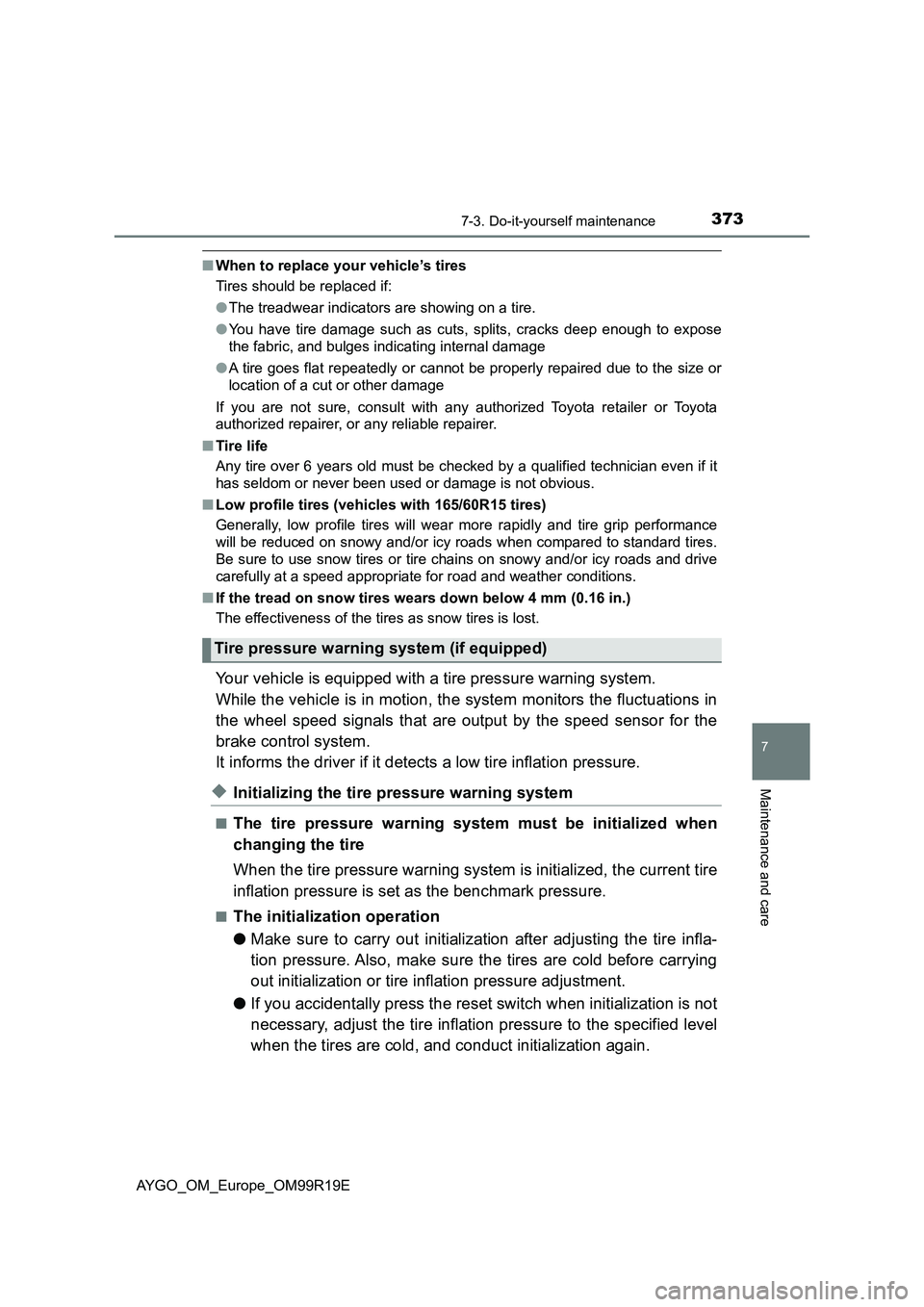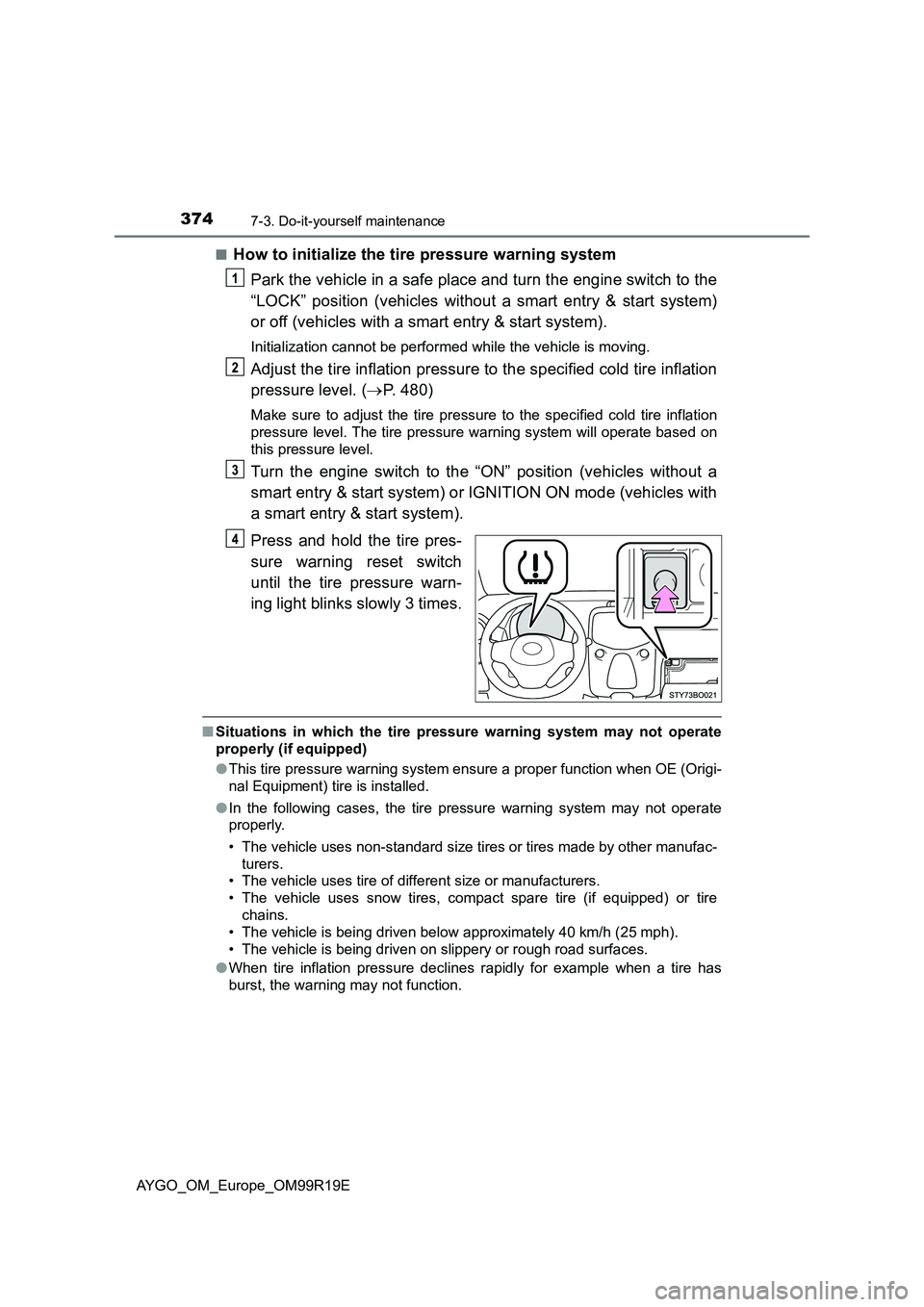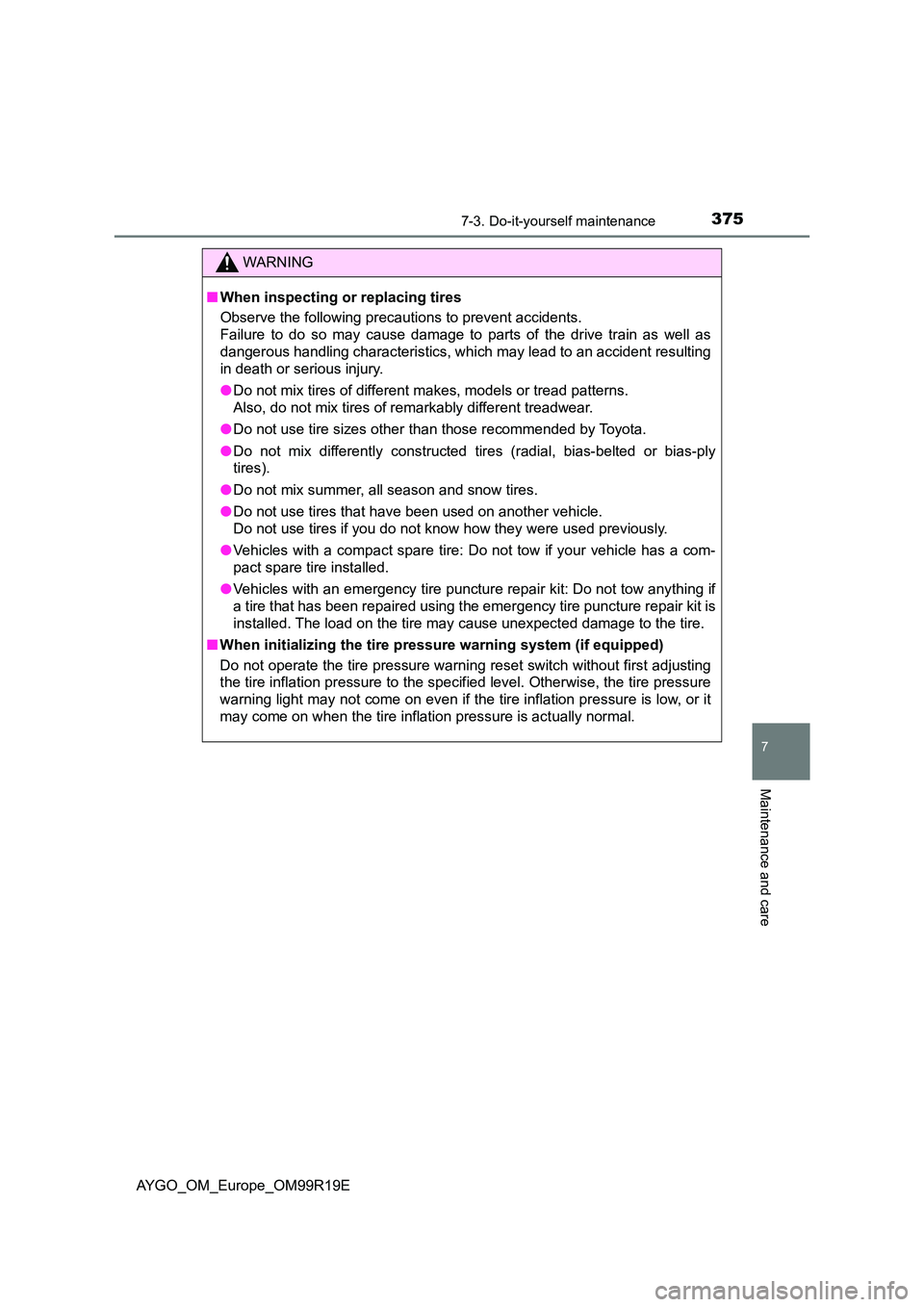2019 TOYOTA AYGO warning
[x] Cancel search: warningPage 373 of 504

3737-3. Do-it-yourself maintenance
7
Maintenance and care
AYGO_OM_Europe_OM99R19E
■When to replace your vehicle’s tires
Tires should be replaced if:
● The treadwear indicators are showing on a tire.
● You have tire damage such as cuts, splits, cracks deep enough to expose
the fabric, and bulges indicating internal damage
● A tire goes flat repeatedly or cannot be properly repaired due to the size or
location of a cut or other damage
If you are not sure, consult with any authorized Toyota retailer or Toyota
authorized repairer, or any reliable repairer.
■ Tire life
Any tire over 6 years old must be checked by a qualified technician even if it
has seldom or never been used or damage is not obvious.
■ Low profile tires (vehicles with 165/60R15 tires)
Generally, low profile tires will wear more rapidly and tire grip performance
will be reduced on snowy and/or icy roads when compared to standard tires.
Be sure to use snow tires or tire chains on snowy and/or icy roads and drive
carefully at a speed appropriate for road and weather conditions.
■ If the tread on snow tires wears down below 4 mm (0.16 in.)
The effectiveness of the tires as snow tires is lost.
Your vehicle is equipped with a tire pressure warning system.
While the vehicle is in motion, the system monitors the fluctuations in
the wheel speed signals that are output by the speed sensor for the
brake control system.
It informs the driver if it detects a low tire inflation pressure.
◆Initializing the tire pressure warning system
■The tire pressure warning system must be initialized when
changing the tire
When the tire pressure warning system is initialized, the current tire
inflation pressure is set as the benchmark pressure.
■The initialization operation
● Make sure to carry out initialization after adjusting the tire infla-
tion pressure. Also, make sure the tires are cold before carrying
out initialization or tire inflation pressure adjustment.
● If you accidentally press the reset switch when initialization is not
necessary, adjust the tire inflation pressure to the specified level
when the tires are cold, and conduct initialization again.
Tire pressure warning system (if equipped)
Page 374 of 504

3747-3. Do-it-yourself maintenance
AYGO_OM_Europe_OM99R19E
■How to initialize the tire pressure warning system
Park the vehicle in a safe place and turn the engine switch to the
“LOCK” position (vehicles without a smart entry & start system)
or off (vehicles with a smart entry & start system).
Initialization cannot be performed while the vehicle is moving.
Adjust the tire inflation pressure to the specified cold tire inflation
pressure level. ( P. 480)
Make sure to adjust the tire pressure to the specified cold tire inflation
pressure level. The tire pressure warning system will operate based on
this pressure level.
Turn the engine switch to the “ON” position (vehicles without a
smart entry & start system) or IGNITION ON mode (vehicles with
a smart entry & start system).
Press and hold the tire pres-
sure warning reset switch
until the tire pressure warn-
ing light blinks slowly 3 times.
■ Situations in which the tire pressure warning system may not operate
properly (if equipped)
● This tire pressure warning system ensure a proper function when OE (Origi-
nal Equipment) tire is installed.
● In the following cases, the tire pressure warning system may not operate
properly.
• The vehicle uses non-standard size tires or tires made by other manufac-
turers.
• The vehicle uses tire of different size or manufacturers.
• The vehicle uses snow tires, compact spare tire (if equipped) or tire
chains.
• The vehicle is being driven below approximately 40 km/h (25 mph).
• The vehicle is being driven on slippery or rough road surfaces.
● When tire inflation pressure declines rapidly for example when a tire has
burst, the warning may not function.
Page 375 of 504

3757-3. Do-it-yourself maintenance
7
Maintenance and care
AYGO_OM_Europe_OM99R19E
WARNING
■When inspecting or replacing tires
Observe the following precautions to prevent accidents.
Failure to do so may cause damage to parts of the drive train as well as
dangerous handling characteristics, which may lead to an accident resulting
in death or serious injury.
● Do not mix tires of different makes, models or tread patterns.
Also, do not mix tires of remarkably different treadwear.
● Do not use tire sizes other than those recommended by Toyota.
● Do not mix differently constructed tires (radial, bias-belted or bias-ply
tires).
● Do not mix summer, all season and snow tires.
● Do not use tires that have been used on another vehicle.
Do not use tires if you do not know how they were used previously.
● Vehicles with a compact spare tire: Do not tow if your vehicle has a com-
pact spare tire installed.
● Vehicles with an emergency tire puncture repair kit: Do not tow anything if
a tire that has been repaired using the emergency tire puncture repair kit is
installed. The load on the tire may cause unexpected damage to the tire.
■ When initializing the tire pressure warning system (if equipped)
Do not operate the tire pressure warning reset switch without first adjusting
the tire inflation pressure to the specified level. Otherwise, the tire pressure
warning light may not come on even if the tire inflation pressure is low, or it
may come on when the tire inflation pressure is actually normal.
Page 376 of 504

3767-3. Do-it-yourself maintenance
AYGO_OM_Europe_OM99R19E
WARNING
■Maintenance of the tires (vehicles with the tire pressure warning sys-
tem)
Each tire, including the spare (if provided), should be checked monthly
when cold and inflated to the inflation pressure recommended by the vehi-
cle manufacturer on the vehicle placard or tire inflation pressure label (tire
and load information label). (If your vehicle has tires of a different size than
the size indicated on the vehicle placard or tire inflation pressure label [tire
and load information label], you should determine the proper tire inflation
pressure for those tires.)
As an added safety feature, your vehicle has been equipped with a tire
pressure monitoring system (TPMS-tire pressure warning system) that illu-
minates a low tire pressure telltale (tire pressure warning light) when one or
more of your tires is significantly under-inflated. Accordingly, when the low
tire pressure telltale (tire pressure warning light) illuminates, you should
stop and check your tires as soon as possible, and inflate them to the
proper pressure. Driving on a significantly under-inflated tire causes the tire
to overheat and can lead to tire failure. Under-inflation also reduces fuel effi-
ciency and tire tread life, and may affect the vehicle’s handling and stopping
ability.
Please note that the TPMS (tire pressure warning system) is not a substi-
tute for proper tire maintenance, and it is the driver’s responsibility to main-
tain correct tire pressure, even if under-inflation has not reached the level to
trigger illumination of the TPMS low tire pressure telltale (tire pressure
warning light).
Your vehicle has also been equipped with a TPMS (tire pressure warning
system) malfunction indicator to indicate when the system is not operating
properly. The TPMS (tire pressure warning system) malfunction indicator is
combined with the low tire pressure telltale (tire pressure warning light).
When the system detects a malfunction, the telltale will flash for approxi-
mately one minute and then remain continuously illuminated. This
sequence will continue upon subsequent vehicle start-ups as long as the
malfunction exists. When the malfunction indicator is illuminated, the sys-
tem may not be able to detect or signal low tire pressure as intended.
TPMS (tire pressure warning system) malfunctions may occur for a variety
of reasons, including the installation of replacement or alternate tires or
wheels on the vehicle that prevent the TPMS (tire pressure warning system)
from functioning properly. Always check the TPMS (tire pressure warning
system) malfunction telltale after replacing one or more tires or wheels on
your vehicle to ensure that the repl acement or alternate tires and wheels
allow the TPMS (tire pressure warning system) to continue to function prop-
erly.
Page 377 of 504

3777-3. Do-it-yourself maintenance
7
Maintenance and care
AYGO_OM_Europe_OM99R19E
NOTICE
■Precaution when installing a different tire (vehicles with the tire pres-
sure warning system)
When differently constructed tires or tires of different makers, models or
tread patterns are installed, the tire pressure warning system may not oper-
ate properly.
■ Driving on rough roads
Take particular care when driving on roads with loose surfaces or potholes.
These conditions may cause losses in tire inflation pressure, reducing the
cushioning ability of the tires. In addition, driving on rough roads may cause
damage to the tires themselves, as well as the vehicle’s wheels and body.
■ Low profile tires (vehicles with 165/60R15 tires)
Low profile tires may cause greater damage than usual to the tire wheel
when sustaining impact from the road surface. Therefore, pay attention to
the following:
● Be sure to use proper tire inflation pressure. If tires are under-inflated, they
may be damaged more severely.
● Avoid potholes, uneven pavement, curbs and other road hazards. Failure
to do so may lead to severe tire and wheel damage.
■ If tire inflation pressure of each tire becomes low while driving
Do not continue driving, or your tires and/or wheels may be ruined.
Page 379 of 504

3797-3. Do-it-yourself maintenance
7
Maintenance and care
AYGO_OM_Europe_OM99R19E
WARNING
■Proper inflation is critical to save tire performance
Keep your tires properly inflated.
If the tires are not properly inflated, the following conditions may occur
which could lead to an accident resulting in death or serious injury:
● Excessive wear
● Uneven wear
● Poor handling
● Possibility of blowouts resulting from overheated tires
● Air leaking from between tire and wheel
● Wheel deformation and/or tire damage
● Greater possibility of tire damage while driving (due to road hazards,
expansion joints, sharp edges in the road, etc.)
NOTICE
■ When inspecting and adjusting tire inflation pressure
Be sure to put the tire valve caps back on.
If a valve cap is not installed, dirt or moisture may get into the valve and
cause an air leak, resulting in decreased tire inflation pressure.
Page 381 of 504

3817-3. Do-it-yourself maintenance
7
Maintenance and care
AYGO_OM_Europe_OM99R19E
■When removing the wheel ornament (vehicles with steel wheels and
emergency tire puncture repair kit)
Remove the wheel ornament using the
wheel cap clip. ( P. 429)
WARNING
■When replacing wheels
● Do not use wheels that are a different size from those recommended in the
Owner’s Manual, as this may result in a loss of handling control.
● Never use an inner tube in a leaking wheel which is designed for a tube-
less tire. Doing so may result in an accident, causing death or serious
injury.
■ Use of defective wheels prohibited
Do not use cracked or deformed wheels.
Doing so could cause the tire to leak air during driving, possibly causing an
accident.
Page 385 of 504

3857-3. Do-it-yourself maintenance
7
Maintenance and care
AYGO_OM_Europe_OM99R19E
■Use a CR2016 (vehicles without a smart entry & start system), or CR2032
(vehicles with a smart entry & start system) lithium battery
● Batteries can be purchased at any authorized Toyota retailer or Toyota
authorized repairer, or any reliable repairer, local electrical appliance shops
or camera stores.
● Replace only with the same or equivalent type recommended by the manu-
facturer.
● Dispose of used batteries according to the local laws.
■ If the key battery is depleted
The following symptoms may occur:
● The smart entry & start system (if equipped) and wireless remote control will
not function properly.
● The operational range will be reduced.
WARNING
■Removed battery and other parts
These parts are small and if swallowed by a child, they can cause choking.
Keep away from children. Failure to do so could result in death or serious
injury.
■ Certification for the electronic key battery
CAUTION
RISK OF EXPLOSION IF BATTERY IS REPLACED BY AN INCORRECT
TYPE. DISPOSE OF USED BATTERIES ACCORDING TO THE
INSTRUCTIONS
NOTICE
■ For normal operation after replacing the battery
Observe the following precautions to prevent accidents:
● Always work with dry hands.
Moisture may cause the battery to rust.
● Do not touch or move any other component inside the remote control.
● Do not bend either of the battery terminals.